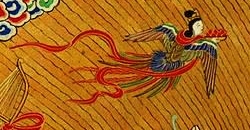Kalaviṅka
Fantastical creature in Buddhism From Wikipedia, the free encyclopedia
Kalaviṅka (Sanskrit: कलविंक kalaviṅka; Pali: karavika; Chinese: 迦陵頻伽 Jiālíngpínqié;[1] Japanese: 迦陵頻伽, romanized: Karyōbinga,[2] Korean: 가릉빈가;[3] Vietnamese: Ca Lăng Tần Già; Burmese: ကရဝိက် karawik; Thai: การเวก, Malay: karawek) is a fantastical immortal creature in Buddhism, with a human head and a bird's torso, with long flowing tail.[4]

The kalaviṅka is said to dwell in the Western pure land and is reputed to preach the Dharma with its fine voice.[4] It is said to sing while still unhatched within its eggshell.[citation needed] Its voice is a descriptor of the Buddha's voice. In the Japanese text, it goes by various titles such as myōonchō (妙音鳥, "exquisite sounding bird"),[5] kōonchō (好音鳥, "goodly sounding bird")[5] among others.
Edward H. Schafer notes that in East Asian religious art the Kalaviṅka is often confused with the Kinnara, which is also a half-human half-bird hybrid mythical creature, but that the two are actually distinct and unrelated.[6]
Depictions
Summarize
Perspective
In Burmese art

The karaweik is commonly used as a motif in traditional Burmese royal barges. The Karaweik located on Yangon's Kandawgyi Lake is an iconic reproduction of the karaweik royal barge.
In Chinese art
In Chinese mural art, it is portrayed as a human-headed, bird-bodied being.[citation needed] In the murals of Dunhuang (敦煌) they appear as figures both dancing and playing music.[citation needed]
- Grey pottery sculpture of a Kalaviṅka (missing its head) from the Yuan dynasty capital of Dadu.
- China, mid-Tang Dynasty. Artwork from the Dunhuang Grottos, Yulin Cave number 25 showing a Bird of Life (共命鸟), playing a panpipe.
- China, mid-Tang Dynasty. Artwork from the Dunhuang Grottos, Yulin Cave number 25 showing a Bird of Life, playing a pipa, with a dancer playing drum
In Japanese art


A well-known example is the pair of kalaviṅka carved in openwork (sukashibori) onto a Buddhist hanging ornament called the keman, used in the golden hall of Chūson-ji temple in Iwate Prefecture. The kalaviṅka from this ornament was commemorated on a 120-yen definitive stamp issued Nov. 1, 1962.[7] The pose and general appearance of this piece are similar to the ones seen on the octagonal pedestal of the same temple (pictured right).
- In another keman from the Tokugawa period (see keman page), the creatures stand more bipedally erect and hence more humanlike.
- In the ancient courtly dance performance Gagaku - karyobin (迦陵頻) is the name of dance expressive of the kalaviṅka, and is danced in pair with the kochō (胡蝶), a dance of butterfly motif. The paired dancing is called tsugai-mai (番舞).
- A kalaviṅka painting by the brushstrokes of Hasegawa Tōhaku resides in Daitoku-ji (Kyoto), inside the Kinmōkaku (金毛閣) erected by tea-master Sen no Rikyū.
- Painted on the ceiling of Tōfuku-ji's Sanmon gate (Kyoto).
- Painted on the ceiling of Myōshin-ji's Sanmon gate (Kyoto), normally not open to the public.
- The Mizusawa Kannon [ja] at 214 Mizusawa, in the former city of Ikaho, Gunma, Main Hall, front right ceiling, painting of a heavenly woman with eagle-like talons, anonymous.
- Kawakami Sadayakko (Sada Yacco), billed as the first overseas Japanese actress, late in her life, built a villa located at Unumahōshakujichō, Kagamihara, Gifu. The villa was christened Banshōen (萬松園) by Itō Hirobumi, and the room with the Buddhist altar has a ceiling painting of kalaviṅka, which may be peered from outside (but access to premises only on Tuesday mornings).
In Tangut art
The Kalaviṅka is a common feature of Tangut art created during the Western Xia period (1038–1227).
- Western Xia Glazed pottery Kalaviṅka-shaped architectural ornament.
- Western Xia Grey pottery Kalaviṅka-shaped architectural ornament.
In Hinduism
Kalavinka was born from one of the head of Vishvaroopacharya who was beheaded by Indra. Indra was angry when Vishwaroopacharya was found to be praying for demons instead of gods. Indra cut his three heads which respectively became Kalavinka, Kapinjala, and Tittiri (all birds)[8]
Popular culture
- (Manga)
- RG Veda by CLAMP: Ancient Hindu mythology theme. A sickly princess character.
- Dream Saga (夢幻伝説 タカマガハラ, Mugen Densetsu Takamagahara) by Megumi Tachikawa : based on Amano-Iwato legend. A sacred bird character.
- (Novels)
- Nightingale no chinmoku [ja] (ナイチンゲールの沈黙 Nightingale's silence) by Takeru Kaidō [ja], bestselling medical fiction author:
- Takaoka Shnno Kokai ki [ja](高丘親王航海記 Prince Takaoka's voyages) by Tatsuhiko Shibusawa
- Akame shijū ya taki shinjū misui [ja] (赤目四十八瀧心中未遂 Akame forty-eight waterfall suicide pact attempt) by Chōkitsu Kurumatani [ja]: Tattooed on the back of Aya, a female character.
- (Music)
- (Cycling)
- The Tokyo-based Tsukumo Cycle Sports's brand is Kalavinka. Many of the bikes feature the Karyōbinga kanji as well as a head badge which features the image of the karyoubinga with the head of a bodhisattva bosatsu and the winged body of a bird.[9]
See also
References
External links
Wikiwand - on
Seamless Wikipedia browsing. On steroids.





